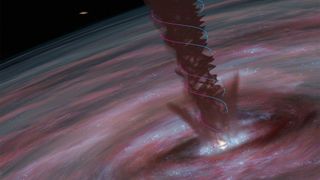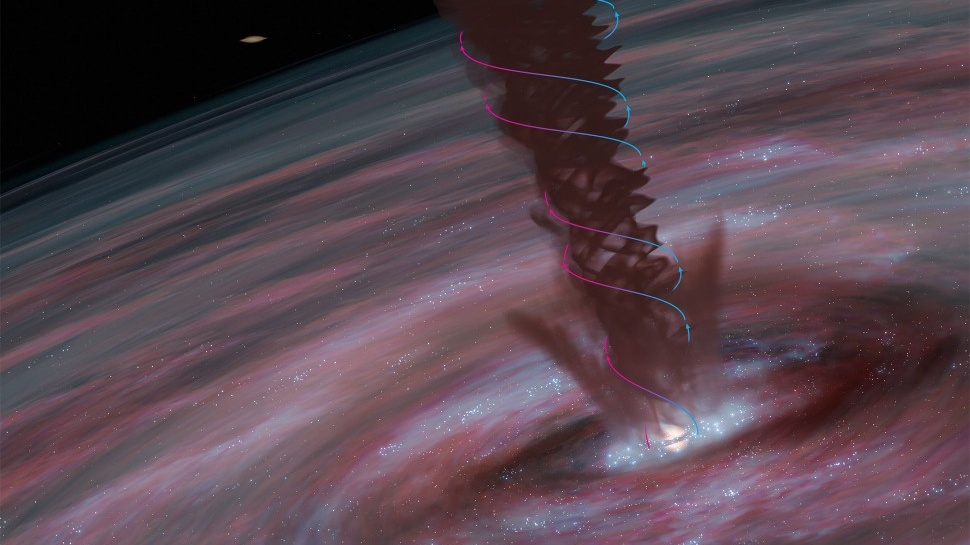
An artist’s impression of the spiraling magnetic wind around the supermassive black hole at the center of the galaxy ESO320-G030. The colored lines show the rotational motion of the wind (blue towards us, red is away from us).
(Image credit: M.D. Gorski/Aaron Geller/Northwestern University/CIERA.)
It’s a bit of a myth that black holes pull everything in. Much of the matter that finds itself falling towards the black hole is actually spat back out, thanks to powerful magnetic fields that are able to levitate charged particles out of a black hole’s accretion disk and accelerate them away.
For a long time, the assumption was that this material flowed radially out from the vicinity of black hole, either through a piercing jet that is collimated by magnetic fields, or material lifted up by outflows of radiation emanating from the hot disk. However, there’s always been a bit of a paradox at the heart of this theory: If the environment immediately around black holes is adept at removing material from danger, how are supermassive black holes able to feed on enough matter to grow to their gargantuan masses of millions or even billions of times the mass of our sun?
Now, observations of the active galaxy ESO320-G030, which is located 120 million light years away, may have just provided the answer. Basically, a spiraling magnetic vortex has been found whirling around a supermassive black hole in a distant galaxy, creating conditions that allow the black hole to feed ravenously.
Using the Atacama Large Millimeter/submillimeter Array (ALMA) in Chile, astronomers led by Mark Gorski of Northwestern University, USA, detected hydrogen cyanide gas being blown by magnetohydrodynamic outflows — in other words, magnetic winds. The hydrogen cyanide isn’t particularly important per se, but by representing the rest of the molecular gas in the system, it acts as a proxy that ALMA can detect.
Related: A massive black hole may be ‘waking up’ in a nearby galaxy
“We wanted to measure light from molecules carried by winds from the galaxy’s core, hoping to trace how the winds are launched by a growing — or soon to be growing — supermassive black hole,” said Susanne Aalto of Chalmers University of Technology in Sweden, who worked with Gorski on the study, in a statement. “By using ALMA we were able to study light from behind thick layers of dust and gas.”
ALMA was able to detect a Doppler effect in the submillimeter radio emission from the hydrogen cyanide, which allowed Gorski’s team to trace the motion of the gas. They found that it was being carried by a rotating magnetic wind, as opposed to the typical radial outflows expected from active black holes. This has a big effect on how the black hole feeds.
Sign up to our newsletter for the latest updates on rocket launches, skywatching events and more!
“In our observations, we see clear evidence of a rotating wind that helps regulate the growth of the galaxy’s central black hole,” said Gorski.
As matter — gas and dust — approaches the black hole, it first bunches up in a rotating accretion disk that is intertwined with magnetic fields that grow more intense as they wind up. Typically, they’re able to lift charged particles up out of the disk and push them away in a focused, magnetically collimated jet. The disk also becomes really hot, radiating at millions of degrees, and this outflow of radiation can also push matter away from the black hole.
However, the rotating magnetic winds are different. “We can see how the winds form a spiraling structure, billowing out from the galaxy’s center,” said Aalto.
Gorski and Aalto’s research paper describes the magnetic wind as “spectacular.” This is because, while the rotational wind can lift charged particles out of the disk, the wind steals some of the disk’s angular momentum as well, because it is also rotating. This causes the rotation of the accretion disk to slow, and, because matter is no longer moving as fast as it was in the disk, the black hole’s gravity is able to pull more of that matter across the event horizon. This allows the black hole to grow faster than it otherwise would as more matter drops into it.
By permitting more matter to fall into the supermassive black hole, this rotating magnetic wind could be the key to unlocking how an AGN — an active galactic nuclei, which is a supermassive black hole in a feeding frenzy — is switched on, prompting a galaxy to turn into a quasar in the most extreme cases.
“Now that we know what to look for, the next step is to find out how common a phenomenon this is,” said Gorski. “And if this is a stage which all galaxies with supermassive black holes go through, what happens to them next? Far from all questions about this process are answered.”
The research was published in April in the journal Astronomy & Astrophysics.
Join our Space Forums to keep talking space on the latest missions, night sky and more! And if you have a news tip, correction or comment, let us know at: community@space.com.
Keith Cooper is a freelance science journalist and editor in the United Kingdom, and has a degree in physics and astrophysics from the University of Manchester. He’s the author of “The Contact Paradox: Challenging Our Assumptions in the Search for Extraterrestrial Intelligence” (Bloomsbury Sigma, 2020) and has written articles on astronomy, space, physics and astrobiology for a multitude of magazines and websites.
>>> Read full article>>>
Copyright for syndicated content belongs to the linked Source : Space.com – https://www.space.com/magnetic-vortices-supermassive-black-hole
